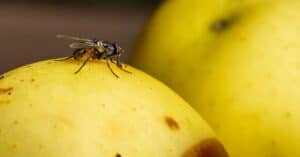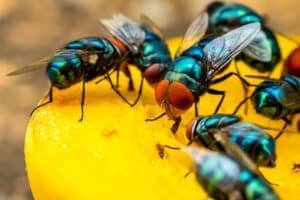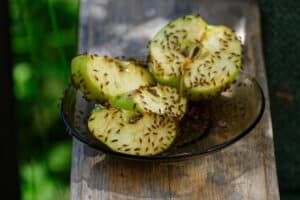Have you ever been relaxing or just going about your day, then suddenly felt a painful bite from what looks like a bug? The bite is often excruciatingly painful and turns red almost immediately. Well, there’s a significant chance that the culprit is a horsefly.
Here’s everything you need to know about this not-so-amazing insect.
What is a Horsefly?
In line with the name, the horsefly is a sturdy insect notorious for mostly preying on horses and other mammals. The bug may be grey or black, with generally light-colored wings that may occasionally be dark.
Its eyes are often large, green or purple, and striped horizontally. Horse flies also have six legs and no bristles, and tiny antennae.
In other parts of the world, horsefly is called cleg, gleg, or breeze flies.
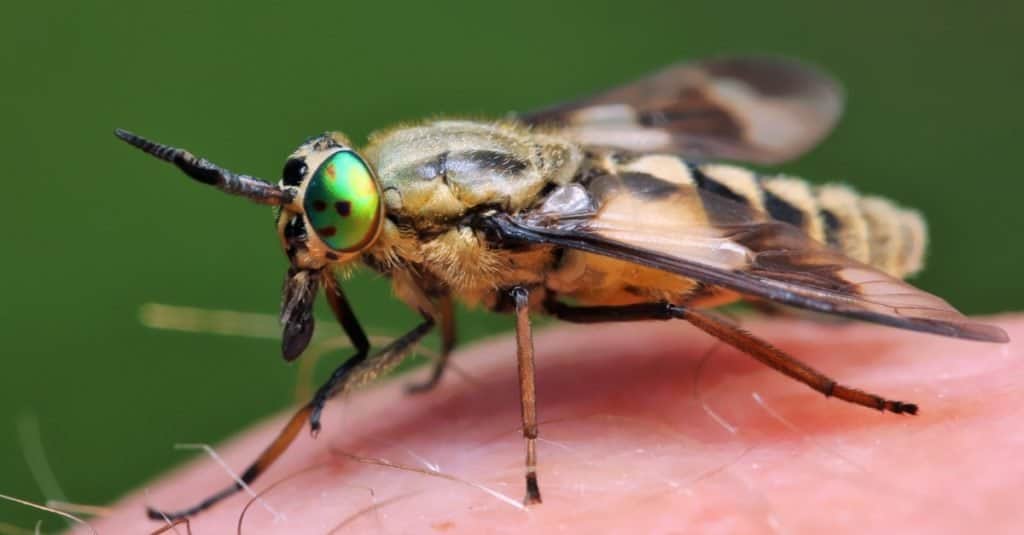
The horsefly has large green or purple eyes and horizontal stripes.
©Achkin/Shutterstock.com
Where Are Horseflies Mostly Found?
Horseflies can be found in any suburban or rural areas around bodies of water. Water bodies are perfect for these bugs because they serve as a breeding ground and home to many mammals. For example, Florida’s large wetland area and extensive regional aquatic plants offer the perfect habitat for these flies.
While the highest population of glegs is found in Great Britain, there is no record of any horsefly in Iceland, Greenland, or Hawaii.
Why Do Horseflies Bite Humans?
While horseflies mainly feed on nectar from flowers, the female needs animal blood during the mating season since, for their eggs to mature following fertilization, they require the blood proteins in animals’ blood. This is comparable to the behavior of other insects, such as mosquitoes.
The female horseflies mate in the summer, which also happens to be the time when humans wear shorts and minimal clothing and spend a considerable amount of time on the beach. They are also attracted to carbon dioxide, which explains why summertime outdoor activities that induce sweating and breathing difficulties attract horseflies. This natural coincidence works perfectly for these insects.
Despite their size, female horseflies need a substantial amount of blood, up to 0.5 milliliters, to reproduce. They may also quickly absorb 200 milligrams of blood.
A unique aspect of the female horsefly is that it releases chemicals that stop blood clots from developing when the skin breaks during biting. In fact, this unique feature explains why historically, horseflies have been used in medicine because of their anti-clotting abilities.

Female horseflies need a substantial amount of blood to reproduce.
©iStock.com/dabjola
How Does A Horsefly Bite Feel?
Arguably, horsefly bites are by far the most painful bites from any insect. These bugs have powerful, slicing mouthparts that sever skin like shears to obtain blood. In contrast to mosquito and tick bites, horsefly bites are extremely painful since they do not produce a moderate anesthetic.
When the horsefly attaches to your skin and begins sucking your blood, it causes severe burns. The biting will continue until the female horsefly has a blood meal or is killed.
What Does A Horsefly Bite Look Like?
Horsefly bites typically result in inflamed skin, itching, and redness. Depending on the type of bite, you may also experience dizziness or a rash known as hives or urticaria.
The rash will go down in a few hours or days.
Is A Horsefly Bite Dangerous?
Horsefly bites are often harmless to humans, causing only temporary discomfort. However, the effect can be lethal if you are allergic to horseflies.
Typically, horses are the only animals impacted by these assaults since they transmit swamp fever, scientifically known as equine infectious anemia.
Once a horse contracts swamp fever, the virus begins to replicate and will be detected in most of the horse’s bodily fluids. The disease causes the horse to exhibit acute or chronic symptoms for days to months.
Unfortunately, swamp fever takes a while before it’s detectable, which causes it to be often disregarded or misdiagnosed. Even after diagnosis, the disease has no known cure, but scientists have worked around the clock to provide solutions to suppress the symptoms.
Once diagnosed, the horse should be quarantined because it will continue carrying the infection after its symptoms have subsided.
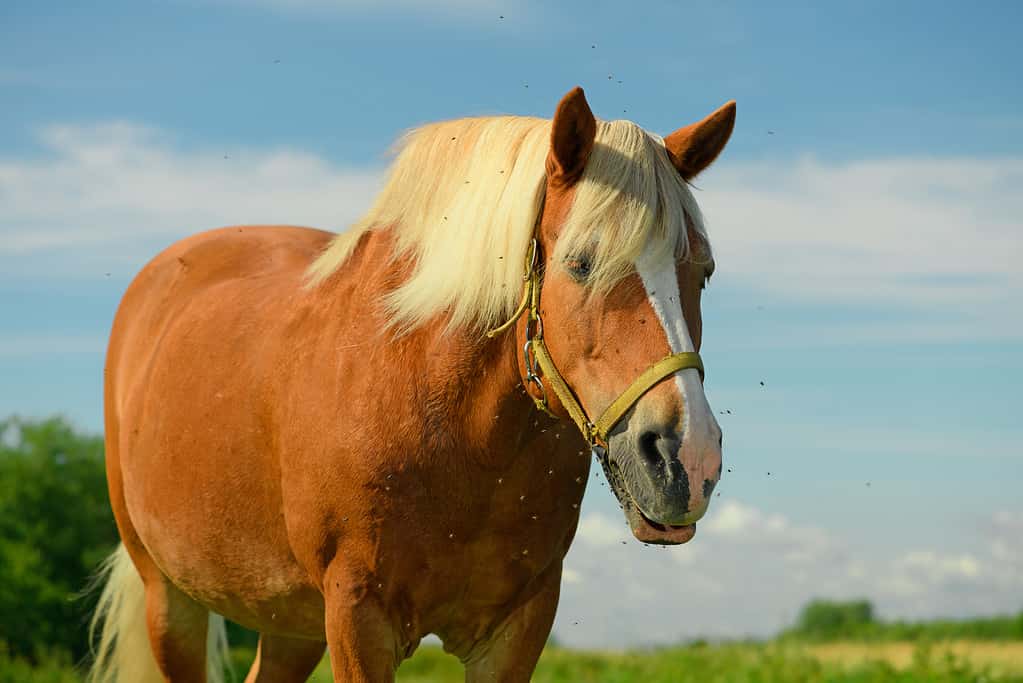
Horseflies can transmit swamp fever to horses which is an infectious disease that affects their immune system.
©iStock.com/Irina Orlova
How Can You Treat A Horsefly Bite?
If a horsefly just bit you, here’s a step-by-step process of what you should do:
- Wash the area using soap and water to get rid of any germs
- Perform a cold press by laying an ice pack on the area affected for about 10 minutes to alleviate the edema.
- Elevate the affected area to try to reduce the swelling.
- Visit a pharmacy and get some painkillers and itch-relieving lotions
Here is what you shouldn’t do despite how much pain you’re in:
- Do not scratch the affected area because doing so could make you susceptible to infections
- While many say sodium bicarbonate and vinegar are the best cures, don’t try them.
Although horsefly bites don’t have extremely adverse effects on humans, if you notice any of these symptoms, call your doctor:
- Dizziness
- Respiratory issues like wheezing.
- Difficulties swallowing
- Swelling of the face, mouth, or throat
- Higher heart rate
- Unconsciousness
- Vomiting
- Pus at the bite site, fever, or enlarged glands are examples of infection signs.
How To Prevent Horsefly Bites
Due to the extensive distribution of their habitats, horseflies might be challenging to avoid in the summer. Nonetheless, certain doable actions can assist in lowering the chances of horsefly bites:
- Wear shoes, long pants, and long-sleeved shirts to cover the skin.
- Wear items of clothing with light colors.
- Avoid tight clothing because horseflies can pierce the fabric.
- Avoid wearing strong perfumes since breeze flies are attracted to scents
- Avoid the water in the summer, when horseflies are breeding there.
- Don’t let small children play outside
How Long Do Horsefly Bites Last?

Horse fly bites are usually red, surrounded by raised skin that is known as a weal.
©Shidlovski/iStock / Getty Images Plus via Getty Images
If the area where you have been bitten is not infected, a horsefly bite will typically last for a few days, or at most seven days. In the majority of cases, the pain and irritation caused are not long-lived and unless your wound becomes infected, there is no cause for concern.
These bites, while painful, are not dangerous to humans as the flies do not transmit severe diseases to them. There are generally no side effects to a bite unless you have an allergy. Should the wound not heal by this time, whether it has become infected, or the pain has gotten worse, or you even show signs of dizziness, you should seek medical attention.
The photo featured at the top of this post is © Eric Isselee/Shutterstock.com
FAQs (Frequently Asked Questions)
What is the best treatment for horsefly bites?
How long does a horsefly bite take to heal?
What attracts horse flies?
Thank you for reading! Have some feedback for us? Contact the AZ Animals editorial team.



